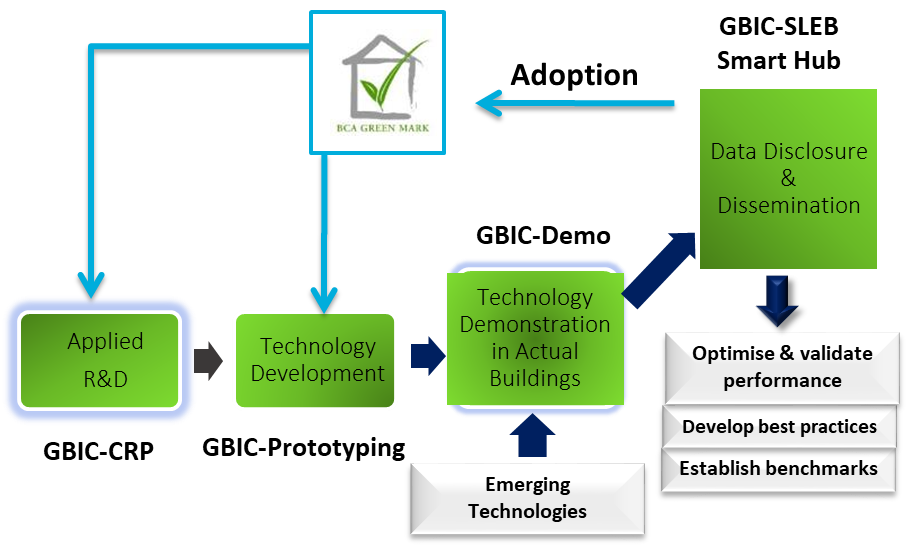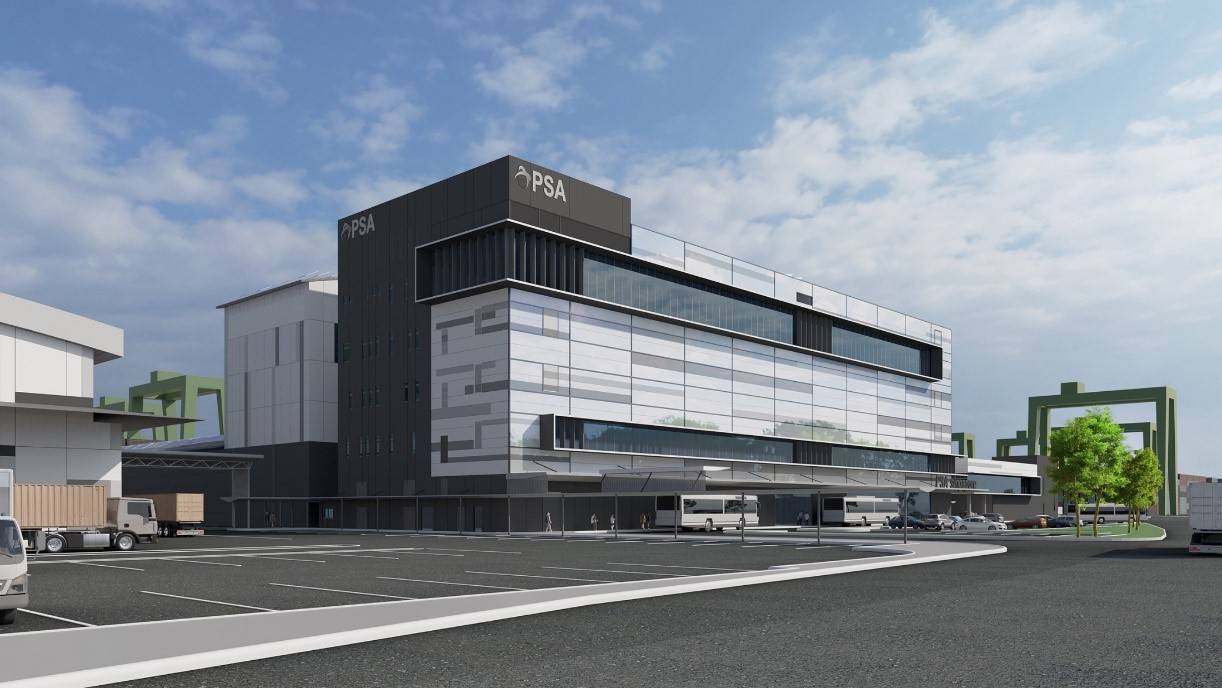Enhanced Green Buildings Innovation Cluster (GBIC)
Background
1 Research, development and demonstration (RD&D) plays a key role in BCA’s Green Building Masterplans, to push the envelope and accelerate the adoption of promising building energy-efficient (EE) technologies and solutions in the industry.
2 In 2014, National Research Foundation Singapore (NRF) provided a funding of $52 million for BCA to set up the Green Buildings Innovation Cluster (GBIC) as a one-stop integrated RD&D hub to experiment, exhibit and exchange knowledge of promising energy-efficiency solutions with stakeholders. Over the past five years, GBIC has supported a total of 32 projects, many of which have been translated into industry solutions and been adopted in actual building projects in Singapore and overseas.
3 Guided by the long-term goal of “super low energy buildings for the tropics”, a Super Low Energy (SLE) Programme and Technology Roadmap was launched in 2018 to bring about significant changes in Singapore’s energy landscape in a whole-of-government effort. Arising from this, NRF will provide additional funding of $20 million to enhance the GBIC programme to further push the boundaries of energy efficiency.
Objectives
4 GBIC will be enhanced towards industry-led and deployment-oriented R&I projects and will serve as the central focal point to reinforce the national drive towards greater energy efficiency as well as to streamline, coordinate and disseminate building EE-related activities. The overall objectives of GBIC are to:
- Develop and demonstrate novel and market-proven solutions in a mix of building types;
- Validate performance, raise and build awareness and capability;
- Proliferate energy efficiency across the built environment.
Key benefits
5 GBIC will consolidate existing green building RD&D efforts and capabilities. It will also provide platforms for the demonstration of promising novel technologies such that they can be brought closer to market adoption. Results of the demonstration projects will be measured and documented in detail. These results can then guide subsequent R&D directions. The experience and learning points from this endeavour will also be shared with industry stakeholders.
Key activities
6 GBIC will now have four key activities; Competitive Research Programme, Prototyping, Demonstration and SLEB Smart Hub.
i. Competitive Research Programme (CRP)
This provides a platform for the industry to collaborate with the local and international R&D community to develop applicable solutions with significant impact in building energy efficiency and with high market adoption potential.
ii. Prototyping [New]
This provides a platform for “out-of-lab” research outcomes to be refined and customised for actual building application and to support promising solutions from local/overseas companies for further development and adoption in our local environment. In addition, it aims to encourage building owners, consultants and the stakeholders to adopt a more holistic approach to strive for greater energy efficiency at an early design stage of the building project.
iii. Demonstration
This serves to demonstrate novel energy efficient technologies that have not been widely implemented locally in operating buildings. The programme aims to link building owners and technology providers with each other in order to establish platforms where industry can test and showcase these technologies to generate local performance data for verification. By doing so, these demonstrated technologies can be replicated in other buildings and eventually, commercialised.
iv. SLEB Smart Hub
This is a centralised national database of building energy efficiency performance data and technologies with powerful smart data tools enabling professionals to make better decisions to adopt innovative technologies. The SLEB Smart Hub will allow companies to share the latest green building technologies with building owners, professionals, researchers and policymakers.

Green Buildings Innovation Cluster Demonstration Project

7 The upcoming Tuas Port will be developed in four phases and terminal operations for the first phase is expected to start in 2021. As part of PSA Singapore’s sustainability plan to reduce carbon emissions, PSA is looking to develop green terminal buildings in the port.
8 This 6-storey Administrative Building (under the Green Building Innovation Cluster Demo) will be part of the Tuas Port Maintenance Base, and will house an operations centre which will manage all terminal operations for Phase 1 of Tuas Port, as well as a canteen, an engineering office and briefing rooms. It is expected to be ready in the fourth quarter of 2020.
9 The Administrative Building will be the first major building and the first Super Low Energy Building (SLEB) to be completed in Tuas Port and is projected to achieve energy savings of 58% over the baseline building design.
10 This translates to an Energy Utilisation Index (EUI) of 98kWh/m²/year compared to the baseline EUI of 235Wh/m²/year. With PSA’s plans to incorporate rooftop PVs for the entire Tuas Maintenance Base which will generate electricity of 2,795 MWh/year, the energy consumption of the Tuas Maintenance Base (including the Administrative Building) would be offset by renewable energies, making it a Net Zero Energy development.
Building Integrated Photo-Voltaics (BIPV)
11 Free from any shade, the Administrative Building is ideal for the installation of building-integrated photovoltaic (BIPV) modules in place of regular cladding in the northern, southern and western façades of the building without adding redundant layers. BIPV is one of the promising renewable energy technologies, and its use in parts of a building envelope such as the roof, skylights and facades will generate a sustainable PV power. A silent system that generates on-site electricity, this BIPV system will reach its peak in power generation at a different time than roof-mounted PV systems on the other buildings within the Maintenance Base and this will balance on-site energy consumption and on-site energy generation. With a total area coverage of about 1,700 sqm, the BIPV system on this building is estimated to generate 130,000 kWh of energy annually.
Other Innovations
12 In addition to BIPV, PSA adopted several innovative technologies arising from R&D as well as emerging technologies that have yet to be widely adopted in Singapore include:
a) Enhanced passive displacement cooling (PDC) system for the office areas. The “Thermosiphon Beam” developed by Nanyang Technological University (NTU) can increase the cooling capacity by 50% compared to existing PDC systems. The technology resulted in the spin-off company Air T&D Pte Ltd;
b) A hybrid evaporative cooling system conceptualised by GreenA Consultants. This mixed-mode versatile system is designed to respond to various weather conditions by combining different cooling technologies such as free cooling, heat recovery cooling and evaporative cooling to achieve thermal comfort for the users;
c) Precision secondary pumping system to replace the conventional primary-pumping system by using the latest digital technologies to deliver chilled water based on precise demand control;
d) Variable air volume (VAV) thermal diffusers integrated with Electronically Commutated (EC) Fan Coil Units (FCUs) to allow greater part-load controls to harness energy savings;
e) Intelligent building management system (BMS) integrated with Indoor Environmental Quality (IEQ) sensors (developed by NUS and spin-off into SenSING Pte Ltd) and the Model Predictive Controls (developed by NTU under GBIC-CRP funding). This system provides real-time data for lighting controls and weather data for ACMV controls; and
f) Thermal breaks in the façade system to reduce thermal heat gains into the building. The testbed will provide insights for the ongoing research project on the enhancement of building code on the Envelop Thermal Transfer Value (ETTV).



